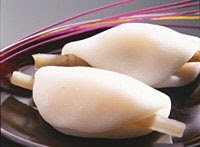Every culture in the world has a soft spot for sweet foods,be it from natural sources like fruits or from confectionery.the Japanese people too have a sweet tooth.they have a wide variety of sweets that are native to their country while some of their sweets and snacks are borrowed from other countries and are slightly modified...
they include:
Imagawayaki (いまがわやき) is a Japanese dessert often found at festivals and other places that one might, in America, find funnel cake. It is made of batter in a special pan (similar to a waffle iron but without the honeycomb pattern), and filled with sweet azuki(あずき) bean paste, although it is becoming increasingly popular to use a wider variety of fillings such as potato and mayonnaise.
Monaka (もなか) is a Japanese sweet made of azuki (あずき) bean filling sandwiched between two thin crisp wafers made from mochi. The wafers may be shaped like cherry blossoms, chrysanthemums and so on. modern monaka can also be eaten filled with ice cream.sounds delicious does'nt it?
Uirō (ういろお) is a steamed cake made of rice flour and sugar. It is chewy, similar to mochi(もち), and subtly sweet. Flavours, among others, include azuki bean paste, green tea (matcha), yuzu, strawberry and chestnut. The Nagoya city is particularly famous for its uirō, but it can also be purchased in traditional Japanese confectionery shops throughout Japan. syrup topping. Yōkan (よおかn) is a thick jellied dessert made of red bean paste, agar, and sugar. It is usually sold in a block form, and eaten in slices. There are two main types: neri yōkan and mizu yōkan. “Mizu (みず)” means “water”, and indicates that it is made with more water than usual. Mizu yōkan is often chilled and eaten in summer Yatsuhashi(やつはし) is a Japanese kind of confectionary, a form of miyagegashi ( みやげがし)sweet sold mainly as a souvenir) from Kyoto. It is one of the best known meibutsu (famous regional products) of Kyoto. It’s made from rice flour (jōshinkoじょおしんこ ), sugar and cinnamon. Baked, it is similar to senbei. Raw yatsuhashi (Nama yatsuhashi) has a soft texture and is often eaten wrapped around red bean paste, and may come in a variety of different flavours.yummy! Botamochi are a springtime treat made with sweet rice and sweet azuki ( あずきred bean) paste. They are made by soaking sweet rice for approximately six hours. The rice is then cooked, and a thick azuki paste is hand-packed around pre-formed balls of rice. Dango (だんご )is a Japanese dumpling made from mochiko (もちこrice flour), related to mochi. It is often served with green tea. There are many different varieties of dango which are usually named after the various seasonings served on or with it. Bocchan dango is dango that has three colors. One is colored by red beans, the second by eggs, and the third by green tea. Kushi dango (くしだんご): Dangos held by a skewer. Mitarashi: A syrup made from shouyu (soy sauce), sugar and starch.looks so sweet,does'nt it? Hanabiramochi - A flat red and white sweet mochi wrapped around anko and a strip of candied gobo (burdock). There are also served at the first tea ceremony of the new year. Taiyaki (”baked sea bream”) is a Japanese fish-shaped cake. like a kaitenyaki. The most common filling is red bean paste that is made from sweetened azuki beans. Other common fillings are custard, chocolate, and cheese. Some shops even sell taiyaki with okonomiyaki or a sausage inside. Taiyaki is made using taiyaki or regular pancake or waffle batter. The batter is poured into a fish-shaped mold for each side. The filling is then put on one side and the mold is closed. It is then cooked on both sides until golden brown.













No comments:
Post a Comment